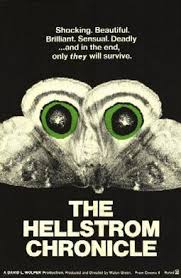“The Hellstrom Chronicle” was released in 1971 and was directed by Walon Green and Ed Spiegel. It is an unusual American docu-drama horror film with some end-of-the-world warnings. It is also one of the creepiest horror movies out there. The film won both the Academy Award for Best Documentary Feature in 1972 and a BAFTA Award for Best Documentary.
Narrated by Dr. Nils Hellstrom (Lawrence Pressman), the film showcases the life and death of various forms of insect life. Dr. Hellstrom is actually a fictitious character invented to present both facts and fiction as if they were the same. The film is laced through with propaganda.
The insect cinematography is fascinating and informative as well as disturbing as hell. It is also accurate in that insect life cycles and community are real. The far-fetched portion of the film is the scientist and his background. A third component of the film is the doomsday prophecies. The idea that insects have the capability to take over the world adds science fiction and horror elements to the movie.
The Hellstrom character, played by Pressman, expounds on various theories concerning the potential of insects to supersede man as the dominate life force on Earth. It also puts forth the theory that mankind is slotted for extinction and the only life form capable of taking over is insects, due to their being adaptable to harsh situations. This is something that humans cannot do since they prefer to change their situation to adapt to their needs instead of adapting to the situation. The theories he puts forth all sound logical, and many of them are. Others are either unproven or just hyperbolic in order to add spice to the narration.
If you have a problem with creepy crawlies then this movie is not for you. Clips of insects doing what they naturally do are disturbing sometimes. There is definitely a horror aspect to the film, especially the parts where insects are swarming over something else and devouring it alive, which you do see in the film. The insect facts in the movie are accurate. Roy Snelling and Charles Hogue, entomologists at the Los Angeles County Museum of Natural History, were technical advisers on the film. The movie is slightly dated but still relevant today.
The appearance of chaos in the world of insects is undermined by the industriousness and subtle patterns that the insects reveal in their day-to-day lives. They look like they are in a panic and mindlessly running around, but they are really displaying instinctual behaviors and doing so in a clear way that reveals each individual creature’s job as part of the whole. They know what they’re supposed to do and they do it unflinchingly.
The film was the inspiration for the 1973 novel “Hellstrom's Hive” by Frank Herbert.
While most insects need food to survive, some species, like certain moths and mayflies, are short-lived adults that only mate and lay eggs, and don't eat at all. When your life span is twelve hours, you don’t have time to stop and eat, you just procreate.


